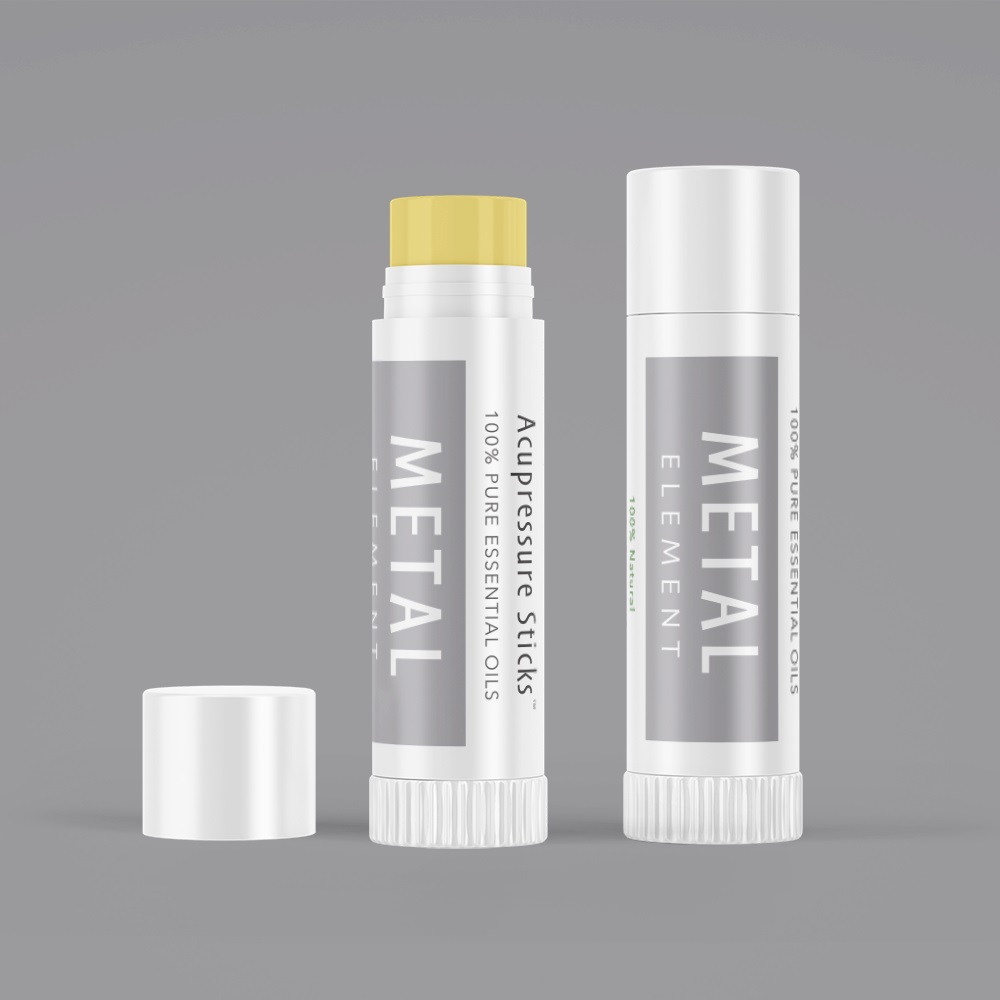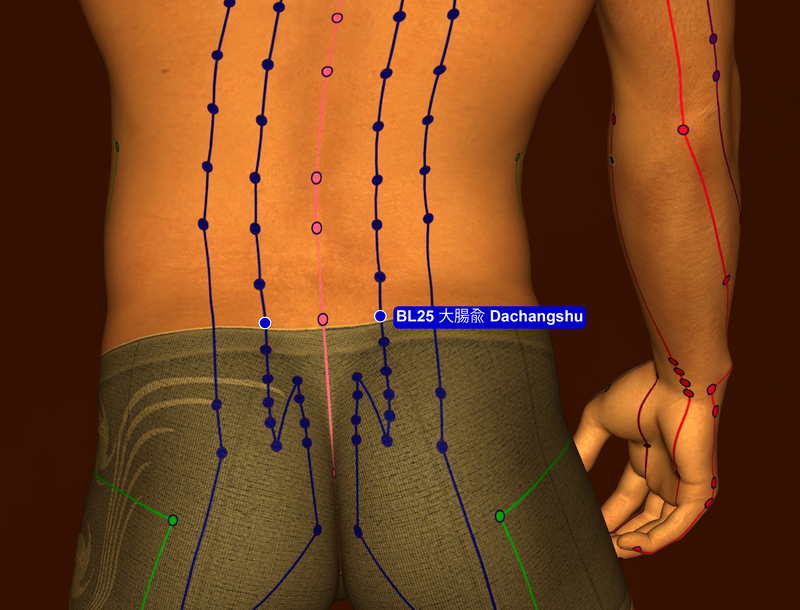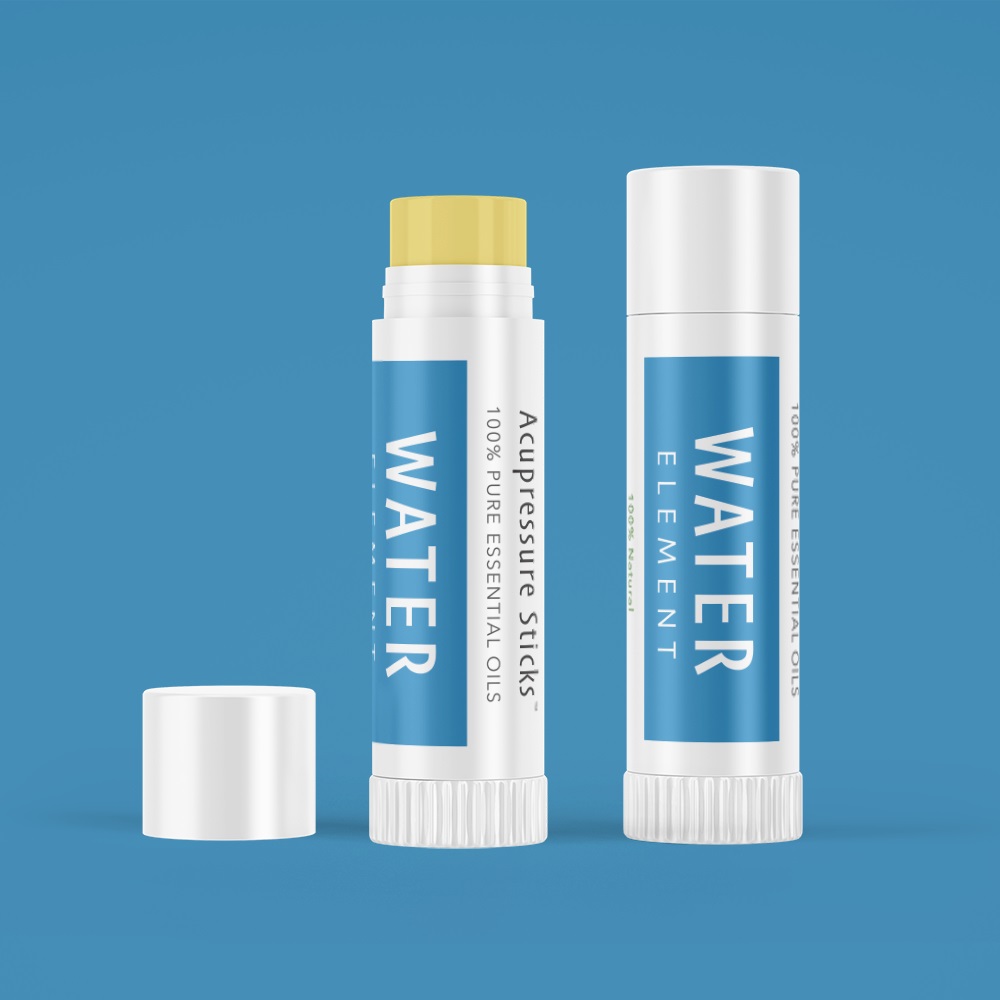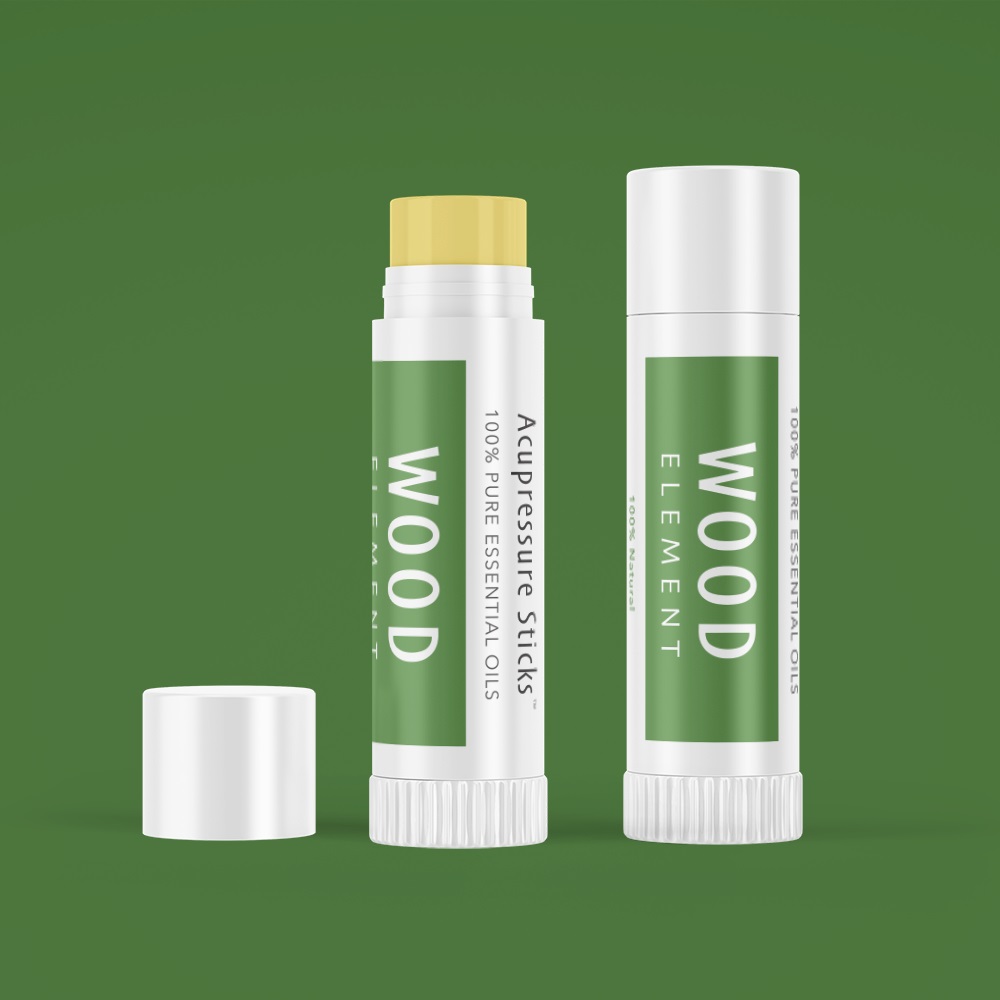Lower Back Pain
Lower Back Pain Relief Strategies
Back pain is the #1 reason that patients consider and pursue Chinese medical treatment including acupuncture, acupressure, herbs and topical remedies with essential oils. Here we explain effective self-care protocols that get to the root causative factor of back pain. The causes of back pain are broken down by the specific patterns of pain syndromes making self-treatment strategies more effective to you. We also address Channel Theory as pain tends to run along the acupuncture Meridians; understanding where the affected Channels are helps to choose the correct acu-points. For best outcomes using self-care, combine associated Aroma Acu-Sticks® to acupuncture points, topical remedies, and good lifestyle practices.
![]()

Aroma Acu-Therapy™ for Lower Back Pain
Small Intestine 3
Apply the Fire Element Aroma Acu-Stick® to activate Acupressure Point SI 3
Why? Acu-point Small Intestine 3 pairs with Acu-point Bladder 62 to activate the Du Mai vessel that travels along the spine.
Apply the Water Element Aroma Acu-Stick® to activate Acupressure Point Bladder 62
Why? Acu-point Bladder 62 stimulates the flow of Qi and Blood to the lower back and break up blockages as the Bladder Channel traverses the back.
Apply the Earth Element Aroma Acu-Stick® to activate Acupressure Point SP 10
Why? Acu-point Spleen 10 is a major point used for Blood Stagnation anywhere in the body and pain cannot occur according to Chinese medicine without Blood and/or Qi Stagnation.
Apply the Wood Element Aroma Acu-Stick® to activate Acupressure Point LV 3
Why? Acu-point Liver 3 regulates the movement of Qi of the body, and where Qi goes, Blood goes according to Chinese medicine.
 Large Intestine 4
Large Intestine 4
Apply the Metal Element Aroma Acu-Stick® to activate Acupressure Point Large Intestine 4
Why? Acu-point LI 4 used along with Acupoint Liver 3 are called the Four Gates and LI 4 serves to amplify the affect of LV 3 in breaking up Qi Congestion in the body.
Related Articles:
- How Aroma Acupressure Works
- Aroma Acu-therapy® Online Course
- Specific Acu-Point Locations
- Chinese Herbs for Trauma and Sports Injuries
Lower Back Pain Causes According to Chinese Medicine
Lower back pain can be caused by a number of different imbalances according to Chinese medicine. By using Chinese medicinal remedies an Aroma Acu-Therapy™, one can tonify the related Energetic Organ System(s) and relieve Qi and Blood Stagnation of the Acupuncture Channels that cause pain, thus, experience long-term relief.
![]()
Kidney Deficiency Causing Lower Back Pain
Kidney Deficiency is the most common underlying cause of lower back pain and lower back pain is a diagnostic indication of Kidney Deficiency. it is especially indicated with lower back pain that is chronic and did not occur because of an injury or traumatic event.
However, even with an injury or traumatic event one could have had a predisposition to lower back injury due to chronic Kidney Deficiency. To clarify, with Kidney Deficient pathology, lower back pain is not necessarily related to nerve impingement syndrome but can be due to weakness of the lower back.
![]()
Kidney Yin Deficiency and Lower Back Pain
Yin deficiency can include lower backache that is a long-term problem with no history of trauma; it just started hurting one day and never went away. With this said, it is important to understand that longstanding Kidney Deficiency can produce weaknesses that make one susceptible to injury and trauma. Other symptoms of Yin deficiency include hot flashes, night sweats, tinnitus, irritability, restlessness and the feeling that your hands and feet are too hot. Herbal tonics are consistent with Chinese medical strategies of re-enforcing the Kidney Energetic Organ System to treat the root cause of the pain.
Acupressure Point Combination Strategy:
Kidney Yang Deficiency and Lower Back Pain
A deficiency of Kidney Yang could also give rise to lower back pain. Other symptoms of Kidney Yang deficiency would be early morning diarrhea, cold hands and feet, lack of energy, pale face, hearing loss, feeling cold all the time, frequent urination, low libido. Also, the lower back would likely feel cold to the touch. This pattern of pain would be relieved with the application of heat.
Acupressure Point Combination Strategy:
- Apply our Moxa Acupressure Stick to Acupressure Point Kidney 3
- Apply our Moxa Acupressure Stick to Acupressure Point Ren 6
![]()
Blood and Qi Stagnation Causing Lower Back Pain
In Chinese medicine it is often said that one cannot have pain without Blood and Qi Stagnation. Another  primary theory states that where Qi goes Blood follows; where Blood goes Qi follows. While Qi and Blood Stagnation are generally seen together, one condition may be more pronounced that the other.
primary theory states that where Qi goes Blood follows; where Blood goes Qi follows. While Qi and Blood Stagnation are generally seen together, one condition may be more pronounced that the other.
Qi is pronounced "Chee" and is sometimes spelled Chi; Qi is basically the energy that circulates throughout your body. Qi is Yang in nature and is responsible for animation of the human form. Qi travels through the 12+ meridians (channels) very much like blood through vessels. Chinese medicine works to insure that Qi is able to move freely, that it is moving in the correct direction, and that there is an abundant availability of Qi. If Qi does not move freely through the channels, pain can develop.
Acupressure Point Combination Strategy:
- Apply the Metal Element Acupressure Stick to Acupressure Point Large Intestine 4
- Apply the Wood Element Acupressure Stick to Acupressure Point Liver 3
- Apply the Earth Element Acupressure Stick to Acupressure Point Stomach 36
- Apply the Water Element Acupressure Stick to Acupressure Point Kidney 3
![]()
Blood Stagnation Causing Lower Back Pain
There are two main causes of Blood Stagnation; one is that there was some local trauma. This could be caused by heavy lifting, a sport's injury, or perhaps even an automobile accident. Any specific trauma to the back will give rise to what we call Blood Stagnation. The treatment principle is the same as with Qi Stagnation. Blood Stasis is the local inflammation, bruising, and purple thick blood that is found at the site of the trauma. The other cause of Blood Stagnation is a long history of Qi Stagnation. The Qi is said to move the Blood. Should the Qi remain Stagnant for long enough, then the local body fluids that are supposed to be flowing begin to stagnate as well.
Acupressure Point Combination Strategy:
- Apply the Metal Element Acupressure Stick to Acupressure Point Large Intestine 4
- Apply the Wood Element Acupressure Stick to Acupressure Point Liver 3
- Apply the Earth Element Acupressure Stick to Acupressure Point Spleen 10
- Apply the Water Element Acupressure Stick to Acupressure Point Kidney 3
![]()
Blood Deficiency Causing Lower Back Pain
Often you will see this condition in the elderly as they become dry, brittle, and inflexible. This is because aging naturally results in Yin Deficiency if measures such as regular Yin tonic herb consumption is not practiced as one ages. Blood is a Yin substance; Liver Blood bathes and nourishes the joints; and the spine is a series of joints.
Acupressure Point Combination Strategy:
- Apply the Earth Element Acupressure Stick to Acupressure Point Stomach 36
- Apply the Metal Element Acupressure Stick to Acupressure Point Large Intestine 4
- Apply the Wood Element Acupressure Stick to Acupressure Point Liver 3
- Apply the Earth Element Acupressure Stick to Acupressure Point Spleen 10
- Apply the Water Element Acupressure Stick to Acupressure Point Kidney 3
![]()
Pain Lower Back, Upper Back, Neck, and Spine
The Bladder Channel travels from the inner canthus of the eye, over the head, up and down the back (twice, and down the back of the leg to the outer edge of the foot. This is why points on the foot are able to alleviate back pain.
The Small Intestine Channel starts at the ulnar side of the pinky finger and travels up the arm, crisscrosses the scapula, traverses the neck to end near the ear. Acupressure Point Small Intestine 3 coupled with Acupressure Point Bladder 62 activate what is known as an extraordinary vessel; in this case, the Du channel which travels the length of the entire spine. This is why these two points used together can alleviate pain so broadly. Therefore, this would be an appropriate protocol for bulging disks, herniated disks, or muscle strain.
Acupressure Point Combination Strategy:
- Apply the Fire Element Acupressure Stick to Acupressure Point Small Intestine 3
- Apply the Water Element Acupressure Stick to Acupressure Point Bladder 62
- Apply the Water Element Acupressure Stick to Acupressure Point Kidney 3
![]()
Liver Qi Stagnation Causing Lower Back Pain
There may also be an emotional component in this particular pathology; for instance, a long history of frustration, resentment or some other really bitter emotional pathology can lead to Liver Qi Stagnation. As it turns out, the Liver governs over the movement of Qi throughout the body. We all get frustrated once in a while and that can give rise to the Qi Stagnation type of back pain, but if it goes on for long enough muscles becomes tighter and more reactive. In this case, the body begins to manifest that stagnation in the form of lumps, tumors, sharp pains or other blood circulation problems.
Acupressure Point Combination Strategy:
- Apply the Metal Element Acupressure Stick to Acupressure Point Large Intestine 4
- Apply the Wood Element Acupressure Stick to Acupressure Point Liver 3
- Apply the Water Element Acupressure Stick to Acupressure Point Kidney 3
Liver-Kidney Imbalances Causing Lower Back Pain with PMS
Lower back pain is sometimes found in women with painful periods and PMS. Dull achy pain is typically experienced just before the onset of menstruation. Additionally, women may notice a bout of very loose stools at the onset or just before menstruation begins.
Acupressure Point Combination Strategy:
- Apply the Water Element Acupressure Stick to Acupressure Point Kidney 3
- Apply the Metal Element Acupressure Stick to Acupressure Point Large Intestine 4
- Apply the Wood Element Acupressure Stick to Acupressure Point Liver 3
- Apply the Earth Element Acupressure Stick to Acupressure Point Spleen 10
![]()
Using Channel Theory to Alleviate Lower Back Pain
Often, those with chronic lower back pain experience pain that runs down the leg. In Chinese medicine we use channel theory to differentiate pain depending on which Acupuncture Channel the pain is located.

Pain Radiates Down Back of Leg
The Bladder Channel runs down the back of the leg. The Kidney energetic organ system and the Bladder energetic organ systems are paired organ systems.
Acupressure Point Combination Strategy:
- Apply the Fire Element Acupressure Stick to Acupressure Point Small Intestine 3
- Apply the Water Element Acupressure Stick to Acupressure Point Bladder 62
- Apply the Water Element Acupressure Stick to Acupressure Point Kidney 3
Pain Radiates Down Side of the Leg
The Gallbladder Channel runs through the sciatic area down the outside of the leg to the lateral malleolus (ankle). The Gallbladder and Liver energetic organ systems are paired in Chinese medicine.
Acupressure Point Combination Strategy:
- Apply the Metal Element Acupressure Stick to Acupressure Point Large Intestine 4
- Apply the Wood Element Acupressure Stick to Acupressure Point Liver 3
- Apply the Wood Element Acupressure Stick to Acupressure Point Gallbladder 34
- Apply the Wood Element Acupressure Stick to Acupressure Point Gallbladder 40
- Apply the Wood Element Acupressure Stick to Acupressure Point Gallbladder 41
- Apply the Water Element Acupressure Stick to Acupressure Point Kidney 3
Related Article: Sciatica Pain Relief
Back Pain That Radiates to the Groin and Front of Leg
Pain from back pain causing sciatica radiating from the SI Joint Radiating to the Front of the Leg and Grin Area is a Gallbladder/Liver Channel association.
Acupressure Point Combination Strategy:
- Apply the Metal Element Acupressure Stick to Acupressure Point Large Intestine 4
- Apply the Wood Element Acupressure Stick to Acupressure Point Liver 3
- Apply the Wood Element Acupressure Stick to Acupressure Point Gallbladder 34
- Apply the Wood Element Acupressure Stick to Acupressure Point Gallbladder 40
- Apply the Wood Element Acupressure Stick to Acupressure Point Gallbladder 41
- Apply the Water Element Acupressure Stick to Acupressure Point Kidney 3
 Natural Lower Back Pain Strategies
Natural Lower Back Pain Strategies
Our typical image of pain killers and analgesics are drugs that block nerve conduction signals to the brain; natural pain treatments work much differently and optimally initiate true healing and long term relief from pain. As with any chronic condition one would have to apply these natural healing modalities over a matter of many months to achieve long-standing relief from back pain. This is where people often get confused with natural therapy thinking that they only use the remedies at the time they are suffering from pain, like one would take an aspirin. Instead, Chinese medicine the goal is not masking the symptom (being pain), but resolving the actual imbalances that are causing the pain; this takes time. Chinese medicine recognizes these common causes of lower back pain:
- Trauma-Trauma due to a sports injury, car accident, improper lifting, or strains are the most common cause of lower back pain and results in Blood Stagnation, Qi Stagnation, and inflammation. This type of lower back pain is acute, and is typically sharp and severe in nature, especially in the early stages. Related Article: Chinese Herbs for Trauma and Sports Injuries
- Deficiency-Overworking, poor lifestyle habits and aging lead to Kidney Deficiencies in Chinese medicine. This condition is typically chronic in nature with dull, achy pain and progresses gradually. Other Kidney Deficient symptoms such as knee pain, tinnitus, coldness, and low energy could also present with this type of lower back pain. This is probably the most important aspect of attaining true and lasting relief from lower back pain. Chinese Kidney Tonic Herbs can be taken over a number of months to restore vitality and strength naturally. The concept of the Organs in Traditional Chinese Medicine is radically different from that of contemporary Western medicine. Understanding this difference is very important because the physiology and pathology of the Organs is fundamental to the understanding and treatment of disease.
- External Invasions-According to Chinese medicinal theory, environmental factors can have a dramatic effect on our health, especially if we are run down. Many people recognize that their pain syndromes are exacerbated with cold or damp weather. This type of lower back pain is often dull, achy and heavy in nature, improving with heat.
Often, those with lower back pain have a combination of all three causes; someone with a weak back from deficiency would be more susceptible to injury. Similarly, if your back were injured and weak, you would be more susceptible to an external invasion of Cold and Damp.
![]()
Healing Strategies for Lower Back Pain in Chinese Medicine
Stimulating the Free Flow of Blood and Qi
Blood in Chinese medicine is similar to the western medical concept, as it circulates nutrients and healing agents in the body. Where Qi goes, Blood follows. If a person’s Blood and Qi are flowing freely, he/she will be pain free; good blood circulation to the lower back will speed healing. Natural herbs such as Red Sage, acupuncture, massage, and essential oils such as cinnamon and rosemary all improve Blood and Qi circulation.
Reduce Inflammation and Clear Heat Inflammation is a natural part of the healing process; however,  excessive swelling can cause additional tissue damage in cases of trauma and strain. Cold therapy is often applied immediately after an injury to stop the inflammation, as cold is quite restricting. This restricting quality of cold therapies will cause increased Blood and Qi stagnation if it is used after the initial 24 hours of an injury. Although cold therapies applied to the lower back, even in deficient conditions, will provide temporary pain relief, it essentially aggravates the condition and delays lower back pain relief; this mistreatment of the condition sometimes results in chronic pain conditions such as arthritis. Learn the correct way to treat traumatic injury here.
excessive swelling can cause additional tissue damage in cases of trauma and strain. Cold therapy is often applied immediately after an injury to stop the inflammation, as cold is quite restricting. This restricting quality of cold therapies will cause increased Blood and Qi stagnation if it is used after the initial 24 hours of an injury. Although cold therapies applied to the lower back, even in deficient conditions, will provide temporary pain relief, it essentially aggravates the condition and delays lower back pain relief; this mistreatment of the condition sometimes results in chronic pain conditions such as arthritis. Learn the correct way to treat traumatic injury here.
More About Acupressure for Lower Back Pain
Backaches are a common pathology among people everywhere. Thanks to the westward expansion of Traditional Chinese medicine, people are coming to appreciate the age old medical wisdom of the Orient. This is especially true with regard to the alleviation of back pain. One of the most common reasons that people seek out an acupressure/acupuncturist is because of lower back pain. Back pain is commonly considered a nerve impingement syndrome. The way it works is that there's some kind of structural problem that prevents the nerves from exiting the spinal cord through the spinal vertebrae and out into the body. When there is something pinching one of these nerves as it exits the spine it causes pain. The common term for this problem is a "pinched nerve".
Qi flows through a network of channels or meridians. This sounds much like our neurological system and some try to relate Qi stagnation as a pinched nerve syndrome; however, this is not entirely accurate because Chinese medicine is able to address back pain without mechanical adjustments to the body, manipulation of the spine, surgery to remove a herniated disc, or any other invasive procedure. Never the less, pain is relieved through Chinese medicine utilizing herbs that break up Qi Stagnation. This begs the question: Is the nerve impingement theory the correct explanation for back pain?
While debating the cause is interesting for theorists, it does little for the sufferer. Left untreated, Qi Stagnation can lead to Blood Stagnation, and what was a dull ache that radiates outward from the central location can become a very sharp fixed pain. Qi and Blood are actually inseparable; this means that prolonged Qi Stagnation will inevitably result in Blood Stagnation since Qi moves the Blood.
One way in which doctors determine if there is a nerve impingement is by having the patient lean to the right, and then to the left in order to see if that movement has any effect on the pain. If it does, then a nerve is being pinched. If that pinching can be relieved, then, presumably, the pain will go away along with it. It is important to note that this is just one way of testing for a nerve impingement syndrome. This test isn't always an end-all diagnostic tool.
While removing the obstruction to the nerve should remove the nerve pain, it doesn't always work. Surgery, which is expensive at best and dangerous at worst, may be considered. Chinese Medicine sees these pains as having several possible etiologies with many possible strategies that are low risk. When Chinese medical practitioners are looking to resolve pain syndromes they consider the specific channels, symptoms, and other symptoms that would point to a specific pattern of imbalance.
![]()
Meng CF, Wang D, Ngeow J, Lao L, Peterson M, Paget S. Acupuncture for chronic low back pain in older patients: a randomized, controlled trial. Rheumatology. 2003;42(12):1508–1517. doi: 10.1093/rheumatology/keg405. [Google Scholar]
Brinkhaus B, Witt CM, Jena S, Linde K, Streng A, Wagenpfeil S, et al. Acupuncture in patients with chronic low back pain: a randomized controlled trial. Arch Intern Med. 2006;166(4):450–457. [Google Scholar]
Witt CM, Jena S, Selim D, Brinkhaus B, Reinhold T, Wruck K, et al. Pragmatic randomized trial evaluating the clinical and economic effectiveness of acupuncture for chronic low back pain. Am J Epidemiol. 2006;164(5):487–496. doi: 10.1093/aje/kwj224. [Google Scholar]
Cho YJ, Song YK, Cha YY, Shin BC, Shin IH, Park HJ, et al. Acupuncture for chronic low back pain: a multicenter, randomized, patient-assessor blind, sham-controlled clinical trial. Spine (Phila Pa 1976) 2013;38(7):549–557. doi: 10.1097/BRS.0b013e318275e601. [Google Scholar]
Qaseem A, Wilt TJ, McLean RM, Forciea MA; Clinical Guidelines Committee of the American College of Physicians. Noninvasive Treatments for Acute, Subacute, and Chronic Low Back Pain: A Clinical Practice Guideline From the American College of Physicians. Ann Intern Med. 2017;166(7):514–530. doi:10.7326/M16-2367
This information has not been evaluated by the Food and Drug Administration. This information is not intended to diagnose, treat, cure, or prevent any disease.




